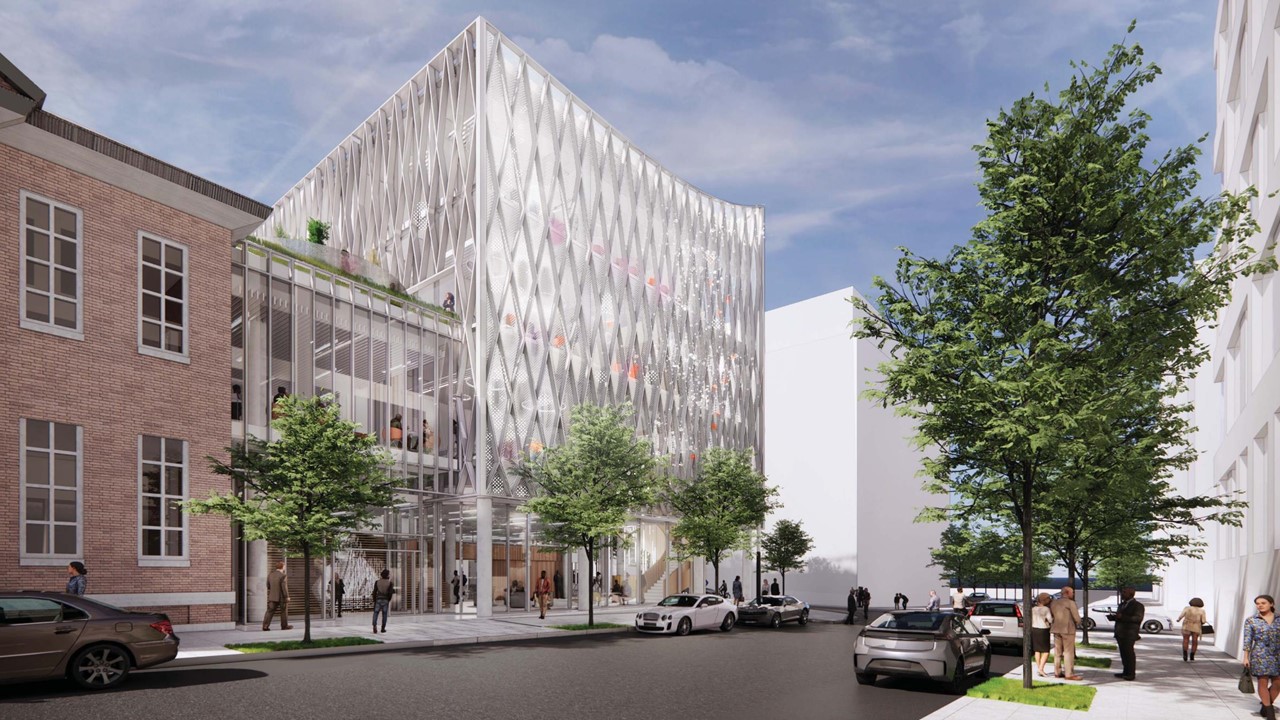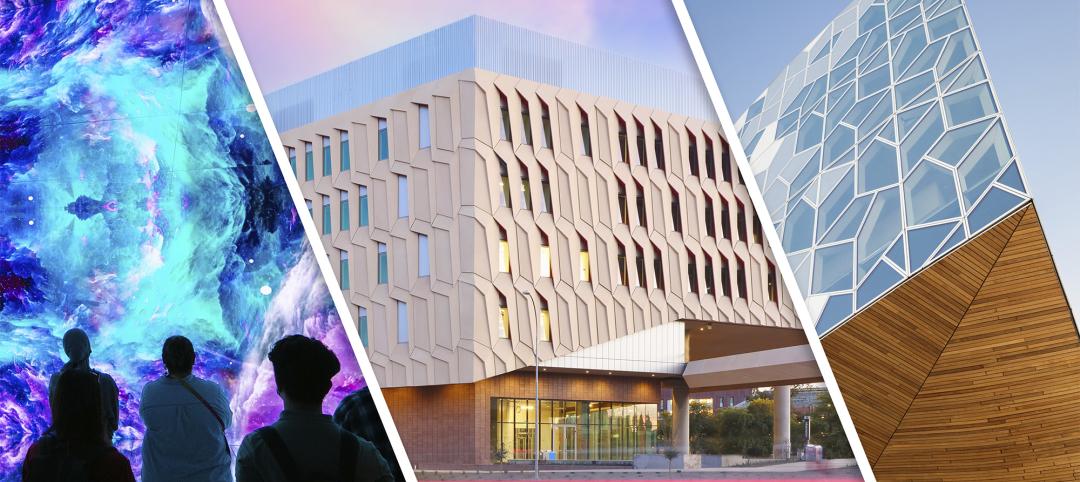In November, Johns Hopkins University and Johns Hopkins Medicine shared the initial design plans for a campus building project named in honor of Henrietta Lacks, the Baltimore County woman whose cells have advanced medicine around the world. Diagnosed with cervical cancer, Lacks, an African-American mother of five, sought treatment at the Johns Hopkins Hospital in the early 1950s. Named HeLa cells, the cell line that began with Lacks has contributed to numerous medical breakthroughs.
In East Baltimore, the roughly 34,000-sf building will adjoin Deering Hall, which houses the Berman Institute of Bioethics. The new building will support multidisciplinary and complementary programs of the Berman Institute and the Johns Hopkins University School of Medicine, as well as other university divisions. It will provide flexible program and classroom space for education and research, as well as meeting space for community use.
The building is meant to inspire efforts to address inequities in biomedical research and healthcare, according to Jeffrey Kahn of the Berman Institute of Bioethics.
The project aims to direct 30% of addressable spend to minority-owned and women-owned businesses and disadvantaged business enterprises, and 20% to local business enterprises. The building is designed and managed by local and/or minority-owned businesses. Vines Architecture, an African American-owned firm based in Raleigh, N.C., completed a yearlong feasibility study for the new building and has been selected as the project’s design architect of record. Turner Construction and Baltimore construction firm Mahogany lead the pre-construction services and provide construction management.
“The design reflects not only [my grandmother’s] strong and beautiful spirit but the important role she plays in the history, and future, of East Baltimore,” Jeri Lacks Whye, granddaughter of Henrietta Lacks and member of the Henrietta Lacks Building Advisory Committee, said in a statement.
Construction is scheduled to start in early 2023, with completion planned for 2025.
Here is the office statement from Johns Hopkins Medicine:
Johns Hopkins University and Johns Hopkins Medicine today presented the initial design plans for the on-campus building project named in honor of Henrietta Lacks, the Baltimore County woman whose cells have advanced medicine around the world, during an Urban Design and Architecture Advisory Panel meeting for Baltimore City Planning. This marks an important milestone in the building project, for which design work will continue through the end of the year.
“The architectural design of the building to be named for Henrietta Lacks reflects Johns Hopkins’ commitment to proudly honor and celebrate Mrs. Lacks’ extraordinary legacy on our campus,” says Ronald Daniels, president of Johns Hopkins University. “We are excited to share these plans with the city’s design and architecture advisory panel, and we look forward to continuing to work closely with the Baltimore community and the family of Henrietta Lacks as this important project moves forward.”
The new, approximately 34,000 square foot building in East Baltimore will adjoin Deering Hall, a historic structure that is home to the Berman Institute of Bioethics. Located at the corner of Ashland and Rutland avenues, in the heart of Baltimore’s Eager Park community, the building will support multidisciplinary and complementary programs of the Berman Institute and the Johns Hopkins University School of Medicine, and other university divisions, and will include flexible program and classroom space to support education and research. Meeting space will also be made available for community use.
"It is exciting to know what the building named in honor of my grandmother, Henrietta Lacks, will look like from the outside, captivating her legacy. I’m happy to see it presented to the Baltimore community,” says Jeri Lacks Whye, granddaughter of Henrietta Lacks and member of the Henrietta Lacks Building Advisory Committee. “The design reflects not only her strong and beautiful spirit but her important role she plays in the history, and future, of East Baltimore.”
“This important building will significantly expand our capacity for teaching, scholarship and community-building, inspiring efforts to address inequities in biomedical research and health care that are an additional tribute to its remarkable namesake,” says Jeffrey Kahn, Ph.D., M.P.H., Andreas C. Dracopoulos director of the Berman Institute of Bioethics.
Construction is planned to start next year. Johns Hopkins also announced that the building will be completed in 2025, with an opening celebration to be planned.
“The expression of this building is unique to its surroundings, as Henrietta Lacks was a unique African American human being in this world. Our team has worked to design a building that fits within the urban context but has a special identity that we hope people believe warrants carrying the name of Henrietta Lacks,” says Victor Vines, president and Robert Thomas, director of design of Vines Architecture. “As we continue progress on the design, we believe that this building will remain a critical way to share the story of Henrietta Lacks for generations to come.”
For more information about the project, visit hopkinsmedicine.org/henriettalacks/updates.html.
About Henrietta Lacks and the HeLa Cells
Henrietta Lacks was a 31-year-old African American mother of five from Baltimore County who sought treatment at The Johns Hopkins Hospital in the early 1950s. Doctors diagnosed Mrs. Lacks with cervical cancer, and as medical records show, she received care that included the best medical treatment available at the time for this terrible disease. Unfortunately, treatment was unsuccessful, and Mrs. Lacks passed away in October 1951.
A sample of Mrs. Lacks’ cancer cells was retrieved during a biopsy and sent to cancer researcher Dr. George Gey's nearby tissue lab, where he had been collecting cells from patients who came to Johns Hopkins Hospital with cervical cancer. He discovered these cells were unlike any of the others he had seen: Where other cells would die, Mrs. Lacks' cells survived, and the number of cells would double every 20 to 24 hours. Soon after that, he began sharing the cells, at no cost, with researchers around the world. Deemed “HeLa” cells, the cell line that began from the biopsy from Mrs. Lacks proved to be remarkably durable and prolific, and while many additional cell lines are in use today, HeLa cells have had a unique contribution to untold medical breakthroughs over the decades since their discovery.
In 2013, Johns Hopkins worked with members of the Lacks family and the National Institutes of Health (NIH) to help craft an agreement that requires scientists to receive permission to use Henrietta Lacks’ genetic blueprint in NIH-funded research.
The NIH committee tasked with overseeing the use of HeLa cells now includes two members of the Lacks family. The biomedical research community has also made significant strides in updating research practices for the donation and use of tissue from patients, in part thanks to the lessons learned from Henrietta Lacks’ story.
To learn more about Henrietta Lacks and the wide-ranging impact of HeLa cells on medical research, please visit hopkinsmedicine.org/henriettalacks.
Related Stories
University Buildings | Jul 11, 2024
3 considerations for designing healthy, adaptable student dining
Amanda Vigneau, IIDA, NCDIQ, LEED ID+C, Director, Shepley Bulfinch, shares three ways student dining facilities have evolved to match changes in student life.
Laboratories | Jul 3, 2024
New science, old buildings: Renovating for efficiency, flexibility, and connection
What does the research space of the future look like? And can it be housed in older buildings—or does it require new construction?
University Buildings | Jun 28, 2024
The American University in Cairo launches a 270,000-sf expansion of its campus in New Cairo, Egypt
In New Cairo, Egypt, The American University in Cairo (AUC) has broken ground on a roughly 270,000-sf expansion of its campus. The project encompasses two new buildings intended to enhance the physical campus and support AUC’s mission to provide top-tier education and research.
University Buildings | Jun 18, 2024
UC Riverside’s new School of Medicine building supports team-based learning, showcases passive design strategies
The University of California, Riverside, School of Medicine has opened the 94,576-sf, five-floor Education Building II (EDII). Created by the design-build team of CO Architects and Hensel Phelps, the medical school’s new home supports team-based student learning, offers social spaces, and provides departmental offices for faculty and staff.
Headquarters | Jun 5, 2024
Several new projects are upgrading historic Princeton, N.J.
Multifamily, cultural, and office additions are among the new construction.
Mass Timber | May 31, 2024
Mass timber a big part of Western Washington University’s net-zero ambitions
Western Washington University, in Bellingham, Wash., 90 miles from Seattle, is in the process of expanding its ABET-accredited programs for electrical engineering, computer engineering and science, and energy science. As part of that process, the university is building Kaiser Borsari Hall, the 54,000-sf new home for those academic disciplines that will include teaching labs, research labs, classrooms, collaborative spaces, and administrative offices.
Products and Materials | May 31, 2024
Top building products for May 2024
BD+C Editors break down May's top 15 building products, from Durat and CaraGreen's Durat Plus to Zurn Siphonic Roof Drains.
University Buildings | May 30, 2024
Washington University School of Medicine opens one of the world’s largest neuroscience research buildings
In St. Louis’ Cortex Innovation District, Washington University School of Medicine recently opened its new Jeffrey T. Fort Neuroscience Research Building. Designed by CannonDesign and Perkins&Will, the 11-story, 609,000-sf facility is one of the largest neuroscience buildings in the world.
University Buildings | May 10, 2024
UNC Chapel Hill’s new medical education building offers seminar rooms and midsize classrooms—and notably, no lecture halls
The University of North Carolina at Chapel Hill has unveiled a new medical education building, Roper Hall. Designed by The S/L/A/M Collaborative (SLAM) and Flad Architects, the UNC School of Medicine’s new building intends to train new generations of physicians through dynamic and active modes of learning.
Student Housing | May 3, 2024
Student housing construction dips in the first quarter of 2024
Investment in college dorms dipped slightly in the first quarter of 2024, but remains higher than a year ago.

















